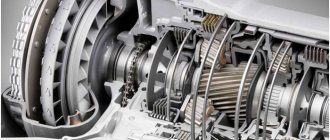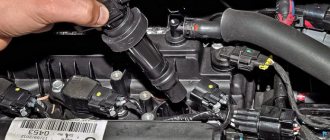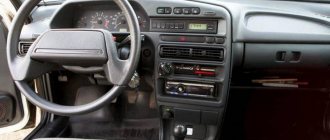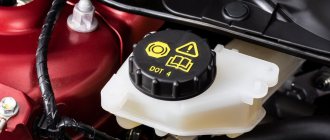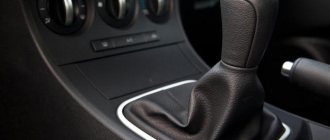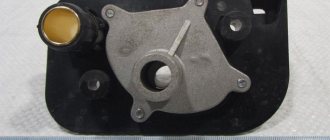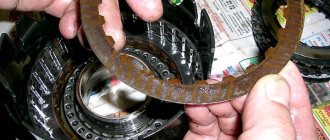01/26/2022 36 124 103 automatic transmission
Author: Ivan Baranov
The automatic transmission, being a rather sensitive unit to improper operation, may periodically work incorrectly, in particular, it may not change gears. In such cases, the car owner has no choice but to take his car to specialists or try to solve the problem on his own. From this material you will learn why the automatic transmission does not change gears, what this may be due to and what to do in such cases.
[Hide]
Gears are difficult to engage with the engine running: possible reasons
At the very beginning, it should be noted that the inability to engage a gear with the engine not running may indicate a serious gearbox malfunction, which consists of failure of the synchronizers. The second reason may be wear or breakage of the gears. It is also possible that the components and mechanisms responsible for transmitting force from the lever in the cabin to the gearbox when selecting a gear may become jammed.
To accurately determine the causes, in the first case it will be necessary to remove the box for disassembly and subsequent troubleshooting; in the second case, it is necessary to identify and replace broken components. In some cases, it is enough to carry out their prevention: removal, lubrication and careful adjustment.
As for problematic switching when the internal combustion engine is running, then the list of the most common faults includes:
- lack of gear oil in the gearbox;
- problems with the clutch mechanism;
Why doesn't the automatic transmission change gears? Looking for the root of the problem
The most common malfunction of modern cars - the automatic transmission does not change gears - has become a real headache for car owners who have managed to enjoy this accessory.
This invention has proven its usefulness and relevance, relieving the driver of many problems when driving, parking, overcoming obstacles, but there are some shortcomings, and to a greater extent - unprofessional use
– often lead to automatic transmission failure.
The automatic transmission does not change gears - such a “diagnosis” can be caused by many reasons
. However, before subjecting the automatic transmission to detailed testing, you need to make sure that this is the cause of the problems with the car: often similar symptoms are caused by malfunctions of other components and assemblies of the car - the fuel system, ignition, gas distribution system, as well as the engine.
Only after making sure that the cause of the problem is the gearbox should you start repairing it (after preliminary diagnostics).
Below we will list the most typical breakdowns characteristic of automatic transmissions of domestic and foreign production. Let us warn you right away: it is impossible to take into account absolutely all options within the framework of the article; we will focus only on the most popular ones.
Recommendations for use
- Forget about slipping - you need to eliminate it by any means necessary. Automatic transmissions have a negative attitude towards slipping, especially in snowy and icy conditions.
- Always warm up the automatic transmission in winter. With an unheated automatic transmission, the likelihood of certain elements of the unit failing is very high.
- Don't use neutral speed in vain. Mode “N” is considered a service mode, so limit its activation.
- Cars with automatic transmissions should not be towed by anyone, since such transmissions are simply not designed for this. Loads have a very negative impact on the design of the unit as a whole. If you plan to drive with a trailer, then keep this factor in mind when purchasing a car.
- Cars with automatic transmission are not allowed.
- Do not tow your car with a rope. While driving, lubricant should always circulate in the transmission, but if the engine is turned off, the TM will not move through the system. Of course, this negatively affects the operation of the unit as a whole.
- Always use only high-quality transmission fluid recommended by your vehicle manufacturer. Remember that using a cheaper lubricant over time can only harm the unit of your car, if not kill it.
Automatic transmission: what not to do
It is strictly forbidden to load a machine that is not warmed up. Even if the air temperature outside the car remains above zero, it is best to cover the first kilometers at low speeds - sharp accelerations and jerks are very harmful to the gearbox. A novice driver should also remember that in order to fully warm up the automatic transmission, it takes more time than to warm up the power unit.
The automatic transmission is not intended for off-road or extreme use. Many modern gearboxes of classical design do not like wheel slipping. The best way to drive in this case is to avoid sudden acceleration on bad roads. If the car is stuck, a shovel will help - do not put too much stress on the transmission.
Also, experts do not recommend overloading classic automatic transmissions with high loads - the mechanisms overheat and, as a result, wear out more and faster. Towing trailers and other cars is a quick death for a machine gun.
In addition, you should not push start cars equipped with automatic transmission. Although many car enthusiasts break this rule, it should be remembered that this will not pass without leaving a mark on the mechanism.
You also need to remember some features in switching. You can remain in neutral, but only if you hold down the brake pedal. In the neutral position, it is prohibited to turn off the power unit - this can only be done in the “Parking” position. It is forbidden to move the selector to “Parking” or to the “R” position while driving.
Causes of machine failure
The following are the main causes of automatic transmission failure:
- resource consumption or wear of parts. The most banal, but at the same time the most common reason. Even neat and careful owners sooner or later come to this situation;
- using low-quality or unsuitable oil. Another common mistake. In pursuit of savings, drivers use uncertified oils. This causes rapid breakdown of the automatic transmission;
- service with low-quality consumables. Here again the savings may be deliberate;
- inexperienced or irresponsible mechanic. You will never guess how decently a person will approach working with a car. Try to contact trusted specialists;
- machine use habits. Many habits lead to wear and tear on parts. A clear example is frequent aggressive driving. But the problems are not limited solely to governance. Warming up the car for a short time in the cold also leads to malfunctions.
Thus, most of the reasons depend on the car owner himself. If something remains unclear to you, please refer to the vehicle manual or the appropriate service center. There you will learn the nuances of operating your car brand and protect the automatic transmission mechanism from breakdowns.
What to do if the automatic transmission does not change gears?
At some point you realized that the gearbox does not change gears, we will try to figure out the reason. The complex device does not allow you to immediately understand why the automatic transmission does not change gears. The reasons can determine the signs that reflect the behavior of the machine. The most correct and common cause of gearbox failure was the driver. Unprofessional use of the car leads to the fact that sooner or later something breaks. The car has become in demand and useful, not everyone will climb under the hood to check the degree of wear of a particular part in order to prevent breakdown before it occurs.
Signs of a torque converter malfunction
- A metallic sound is heard when shifting gears. As the speed increases and load is applied, the sound disappears. This indicates a problem with the bearings. It is necessary to disassemble the torque converter and assess their condition.
- In the speed range of 60-90 km per hour, slight vibration is observed. Over time, its value increases. This is caused by the filter becoming clogged with wear products. In this case, you need to replace the oil filter and oil. Usually it is necessary to change the oil in the gearbox and engine.
- Problems with dynamics indicate a faulty overrunning clutch. It is necessary to disassemble the torque converter and replace the broken clutch.
- The car has stopped and it is impossible to continue driving. This indicates a broken spline on the turbine wheel. Repair of the unit consists of replacing the turbine wheel.
- The occurrence of a rustling noise while the engine is running indicates a malfunction of the bearings located between the torque converter cover and the turbine wheel. The rustling noise may disappear while driving. In this case, you need to contact a car repair shop and carry out repairs. Thrust needle bearings are usually replaced.
- A metallic knock is heard when changing speed. This indicates deformation of the shoulder blades. Repair is carried out by replacing the faulty wheel.
- It is necessary to periodically monitor the condition of the oil in the automatic transmission and torque converter. If aluminum powder appears on the dipstick, you need to check the freewheel, which is made of an aluminum alloy. Most often, the appearance of this powder indicates wear of the end washer.
- With the engine running and standing, there may be a smell of melted plastic near the automatic transmission. This occurs due to overheating of the torque converter and melting of the polymer parts of the assembly. Overheating occurs for a variety of reasons, but is usually due to lubrication. When the oil level decreases, signs of oil starvation of the torque converter and gearbox appear. There may be problems with automatic transmission cooling. In this case, the repair consists of changing the oil and checking the cooling.
- When switching speeds or changing the operating mode of the box, the motor may stall. This indicates a breakdown of the automatic control system that blocks the action of the torque converter. The repair consists of replacing the control unit.
There are no definite signs of a torque converter failure, so technicians sometimes cannot immediately determine the cause of the failure. This leads to increased repair costs and vehicle downtime. If such problems arise with the automatic transmission, the driver needs to contact a car service center as quickly as possible.
Malfunctions of an automatic transmission can be detected in the fact that it is impossible to switch operating modes of the transmission or it is blocked in any gear. In this case, the driver is required to transport the car using a tow truck. Driving independently in a car with a faulty gearbox is prohibited, as this will lead to serious damage to the drive and the entire transmission.
We recommend: Cooling system liquid pump repair
Sometimes a fault can be detected using sensors built inside the box. Such sensors signal a lack of oil pressure, overheating or malfunctions in the gearbox drive. Many signals about malfunctions with the box are vague, and in this case it is not possible to find out an accurate diagnosis even when using computer equipment. A specialist needs to inspect the transmission, remove the box and, after disassembling it, determine the fault.
For those with automatic
If your car has an automatic transmission. It will not hurt you to know the modes in which your machine can operate:
- P – For parking and starting the engine. Switching to this mode is possible only after the machine has completely stopped.
- R – To move backwards. Switching to this mode is also possible only after stopping the car and with the brake pedal pressed.
- N – Neutral. When the engine is completely disconnected from the gearbox.
- D – Moving forward without restrictions on gear shifting (the most commonly used operating mode of the automatic transmission).
- D3(S) – Low gears for climbing and braking engines on descents.
- D2 – Mode for difficult conditions (slippery or mountainous roads). Gears above second are not shifted, that is, only first and second gears are engaged.
- D1(L) - Movement occurs only in 1st gear, used off-road on mud, snow or ice, where you need to drive without changing the throttle, and also to overcome steep climbs.
The automatic transmission also has a button on the mode shift lever with the inscription O/D OFF. When it is turned on, the inclusion is prohibited, increasing the gears of the analogue of the 5th gear of the manual transmission. That is, if your automatic machine has 4 gears for moving forward, then for more dynamic acceleration it will use only three lower gears.
About a faulty automatic transmission, an automatic transmission is much more complex than those encountered with a manual transmission, and the chances of repairing it in your garage are slim. But despite this, you still need to know something about it, if only in order not to harm it through improper use.
An automatic transmission is much more demanding in terms of accuracy in maintaining the oil level in it than a manual transmission. Both too low and too high oil levels are very harmful to her. Both of these can lead to serious damage. In both cases, oil foaming occurs. When there is a lack of oil due to the fact that the oil pump begins to capture air along with the oil. When there is excess oil, it foams on the rotating parts, which in this case are immersed in it. Foamed oil compresses better and has low thermal conductivity. Therefore, if you operate a machine with such oil, the pressure in its control systems will be low. Which will lead to slipping of the clutches and their intensive wear. Deteriorated thermal conductivity will not allow all excess heat to be removed. Which, together with low pressure, will lead to the machine failing and requiring serious repairs.
Foamed oil has more volume. Therefore, checking the oil will show the level is too high. If you find that the oil level has risen for no apparent reason, you need to turn off the engine and let the oil settle. After this, check the level again. If it turns out to be low, you need to safely add the required amount and repeat the test.
The oil level in the machine is checked using a dipstick or through a control hole closed with a plug.
How to check the oil level using a dipstick
- Warm up the oil to operating temperature (to do this you need to drive about 15 km).
Select a flat horizontal area for measurement. Put the car on the handbrake.
- Move the lever to select the operating mode of the box through all positions, holding in each position for 3 to 5 seconds, until the machine operates.
- Leave the mode selector in position P, and in this position determine the oil level.
- Without turning off the engine, remove the oil dipstick, wipe it dry and reinsert it into the tube until it stops, then pull it out and read the readings. The upper limit of oil traces on a dry dipstick should be at the mark with the inscription “hot” or in an area with intersecting notches.
If the level is insufficient, you can add oil through the tube into which the dipstick is inserted. Do not forget that the automatic transmission is afraid of dirt, so add only clean new oil. Wipe the dipstick with a clean cloth from which the threads do not fall out.
When checking the oil level, pay attention to its appearance. Dark liquid with a burning smell indicates that not everything is in order in the unit. First, try changing the oil and filter in the automatic transmission. The milky color of ATF indicates that coolant has entered the box. The coolant softens and swells the material from which the clutches are made. Do not hesitate to change such oil, having first eliminated the cause of antifreeze getting into the box, otherwise significant damage will be caused to the machine. Coolant may enter the box due to a leak in the oil section in the radiator of the cooling system. In this case, the emulsion will be observed both in the box and in the engine cooling system.
The most common machine malfunctions
- The car does not move forward or reverse normally. Possible reasons: wear of the forward clutch clutches, a defect in the piston of this clutch, breakage of the rings of the same clutch, jamming of the valve body valves.
- There is no reverse speed, forward there are only 1 and 2. Probable causes: wear of the reverse clutch clutches, a malfunction of the piston of this clutch, damage to the spline joint in the drum body, another defect of this drum.
- There is no rear, everything works forward. Reasons: wear of the brake band, malfunction of the piston of this band or breakage of its rod, defects in the braking package.
- There is no movement either forward or backward when you turn on any mode, there is a shift push, but the car stands still. Causes: torque converter malfunction, lack of oil, clogged filter.
- Only reverse, 1st and 2nd gears are engaged. Reasons: valve jamming in the valve body, low oil level, general wear of pistons and clutch clutches that do not engage.
Why don't the gears turn on when the engine is running?
Gears may not engage or may not engage fully if the fault is related to the clutch basket. The release bearing may also be the cause. If the specified bearing does not move freely along the input shaft or is jammed, then replacement of the part is necessary.
We recommend reading: How to apply for an old-age social pension
The clarity of gear engagement and the operation of the entire shift mechanism often worries owners of cars with a manual transmission. A common problem is that after starting the engine, one or more gears are engaged with great effort or not completely, it is not possible to change gears, at the moment of switching on, extraneous noise is heard, unnecessary vibrations appear, etc.
What are the types of automatic transmission malfunctions?
It is difficult to imagine the modern world without a car with an automatic transmission. Frequent traffic jams and traffic lights at every intersection made the automatic machine an indispensable thing for moving around cities. Perhaps this is why most significant concerns are gradually abandoning mechanics in favor of automatic gear shifting. This trend is gradually coming to our country, and with it the problems associated with automatic transmissions.
Any current design in a car has two operating principles: mechanical and electronic. Automatic transmission is no exception. Physical gear shifting is carried out by mechanisms, and algorithms are calculated by the software component. Therefore, all causes of failure are divided into two large groups:
- mechanical breakdowns. They occur in the hydraulics and physical drives of the gearbox;
- electronic system failures. Malfunctions of programs or electrical parts of the machine.
Let's look at each of these points separately.
Mechanical and hydraulic problems
Most often, due to mechanical failures, the following elements break:
- wear of the shafts or gears of the mechanism;
- damage or wear of clutches, discs, brakes inside the transmission;
- problems in the operation of the torque converter;
- wear of the hydraulic unit;
- clogging of the oil channels of the box;
- oil pump failure.
From the above list, you can see that the main problems in the mechanical part begin when parts wear out or the use of unsuitable oil. It is worth noting that this is a real stumbling block for automatic transmissions: more often than not, car enthusiasts simply run out of service life of the internal structures of the box. This once again proves the security of this type of transmission.
It is very important to detect and correct automatic transmission problems early . Otherwise, one malfunction will give rise to another, forming a kind of mutual responsibility. So, when the clutch wears out, the oil transmission channels become clogged, and these will lead to problems with the pumping system. Having procrastinated with one problem, some motorists come to services with an almost completely destroyed machine gun. But we'll talk about the reasons a little later.
Electronics and possible problems
Automatic transmission malfunctions do not bypass the electronic internals. We list common examples of broken elements:
- breakdown of electronic components, automatic transmission controller;
- incorrect operation or broken transmission sensors;
- faulty or worn electrical wiring;
- short circuits;
- malfunction of machines, phase devices.
The automatic transmission is designed in such a way that even if the electronic control fails, the car can continue to move. In this case, backup program algorithms are launched: the transmission goes into emergency mode. More often the car automatically switches to 3rd speed. This helps the driver get to the nearest service station and eliminate the cause. Modern systems notify the owner about problems in the electronics.
You can often hear from fans of manual transmissions that if the electrical component breaks down in a car with an automatic transmission, then, unlike a manual transmission, driving it is impossible. As we can see from the example above, this judgment is not true.
Diagnostics
Automatic transmission is popular today both in the domestic car market and in the foreign one. It has more than enough advantages, so it is not surprising that it is so popular. However, like any mechanism, it has the ability to break down. Most often you hear among car owners: the gearbox cannot change gears, you have to do it manually. We will talk about possible causes of failure and their diagnosis further.
First of all, before starting work, you should make sure that the problem is in the automatic transmission. That is, do all other car systems work properly if the engine cannot change gears. There are many problems that lead to a drop in the oil level in the gearbox. The main problem here is a violation of the tightness of the front automatic transmission oil seal.
Reasons for the drop in oil level in the automatic transmission:
- Oil leakage: through the crankshaft seals, through the cylinder block gasket, through the oil filter gasket, through the oil seals. The root of the first problem lies in the wear of the sealing edges of the crankshaft oil seals. This happens either due to the addition of low-quality auto chemicals or low-quality oil. The second problem may be due to overheating of the engine or due to improper tightening of the power bolts when assembling the engine. The most typical cause of the third problem is the rubber sealing ring not being retained in its cage. The fourth problem arises due to overheating of the rubber caps.
- Piston ring problems: wear, overheating, coking. Piston ring wear is a common problem because it always occurs. And, as a rule, this wear begins in areas most exposed to pressure.
- Overheating of oil scraper rings occurs at temperatures above 2000. Any increase in temperature threatens failure of the piston rings. This, in turn, affects the level of oil absorption by the engine.
- Coking of piston rings occurs due to the use of low-quality oil. After all, you must admit that the rings are in good order only when they are movable. Their stagnation negatively affects engine performance.
In addition to these reasons, there are many other reasons for malfunctions of 4 and 5-speed gearboxes.
| Automatic transmission malfunction | Cause |
| After overcoming the rise, the car can switch to a lower gear ahead of time. | Low gearbox oil level, worn discs or o-rings |
| Reverse speed is fine, but the car does not move forward, but skids in place. | Wear of forward clutch discs, clogged gear shift valve, damage to oil rings |
| Shifting forward is normal, moving backward does not occur. | Problems in the operation of the brake band (it is either worn out, torn, or its piston rod is broken), malfunctions of the braking package |
| When the lever is set to neutral, the car moves forward or backward. | The drive cable or lever is not adjusted correctly, the clutch discs or plates are touching |
| The car moves when the gear shift lever is in the “N” position. | Damage to the adjustment of the cable or lever of the automatic transmission control drive, interruptions in the operation of the clutch piston, welding of friction discs to steel |
| Aluminum grains at the bottom of the pan | Wear of either the working layer of the sliding bearing, or the aluminum washer, housing, etc. |
Of course, these are not all the reasons for breakdowns of the automatic transmission itself, but they are the most common. In addition to these, there are also malfunctions of the electronic transmission system. Diagnosis of such problems does not require mechanical intervention in the car; they are detected using a scanner.
The main symptom of a malfunction of the electronic automatic transmission system: the gearbox is in a dead emergency mode, the automatic transmission does not shift.
This indicator refers to problems with malfunction of the engine control unit, malfunction of air flow sensors, malfunction of the gear shift position sensor, etc.
Friction disc wear
When changing gear into an automatic transmission from reverse gear, the car begins to slip. The reasons for the machine's behavior are hidden in:
- displacement or deformation of friction discs;
- rupture of rings or couplings;
- valve sticking.
Disc wear can also affect the performance of the transmission. For example, it is impossible to switch to reverse gear, while at the same time moving forward is only possible in second. The reason for this behavior of the car lies in the wear of components; rubber parts are easily worn out when driving. If, during visual diagnostics, all of the specified parts are intact, then further attention should be paid to the clutch drum; perhaps the reason lies there.
You won't be able to drive a car when it's cold. If, when warming up, the car slips at forward and reverse speeds, then you should pay attention to the properties of the oil used, and if possible, it should be replaced. In addition, there may be another reason for this behavior of the car - a clogged filter.
When starting to move, the car slips in place, the movement itself continues, the speed switches perfectly. This may also indicate wear on the friction discs. In this situation, attention should be paid, among other things, to the condition of the torque converter (hub wear is possible) and to the piston cuffs.
Low gearbox oil level
An insufficient amount of oil in the box makes the process of shifting gears extremely difficult, but the speeds must be engaged. When switching in this way, a metallic crunch is heard, and when driving in a gear, the transmission begins to make a lot of noise and “howl.”
A complete lack of lubrication in the gearbox will not allow you to change gears, since without oil the synchronizers will not be able to work properly, and the gears in the gearbox will not engage.
Any manifestation of these symptoms requires immediate cessation of operation of the vehicle and checking the transmission oil level in the gearbox. It is also necessary to inspect the gearbox for damage to the housing, oil leaks through the seals and gaskets.
It should be noted that for manual transmissions of many cars, the oil in the gearbox is filled from the factory for the entire service life. In practice, replacement is recommended every 60-80 km. mileage
Recommendations from experienced car owners and mechanics
You can often find owners of cars with an automatic transmission that delays switching between speeds. But this is not yet a reason to panic and save large sums of money for repairs. Some problems with tightening can be eliminated in ways that are accessible to everyone.
“A couple of years ago I bought myself a purebred American Mercury 1996. Even during testing, I noticed that the box delayed the shift between the first and second. The former owner said that delaying when choosing a gear is the norm for such a car. After consulting with mechanics, I became convinced that this was not such a terrible disease. I didn’t bother going through the box; I’ve been driving it like this for 2 years. I try to accelerate smoothly, and then this hitch is almost unnoticeable.”
“I have been working at an automatic transmission service station for 8 years. We sort through the boxes of “European” and “Japanese”. Many customers come to us with complaints that the automatic transmission takes too long to shift. We do computer diagnostics for 2 thousand, if it requires repairs, then on average it costs around 15 thousand rubles. Most often, the solenoids on the hydraulic plate need to be replaced; they poison the pressure and delay the change of stages. In terms of time, it takes one day, if there are no queues.”
“I’ve been driving my “swallow” Passat for 8 years now, and recently I started noticing that the automatic transmission is dragging its feet with gears between second and third. This became annoying and forced me to go to a service station with friends. The guys there recommended completely changing the oil using a machine. I didn’t argue; I’ve been servicing my car with them for a long time and trust them. Within a couple of hours, everything was done: oil, filter changed, pan washed, magnet cleaned. After this procedure, the car began to drive like new! I paid 7 thousand for everything, considering that Phoebe took the oil, and it took 12 liters.”
“I got my license while still in college, but I bought the car at a conscious age. I drive carefully and undergo maintenance as required. But a month ago I began to notice that the automatic transmission was slowing down and dragging, and was moving to the third stage late. In a panic, I called the mechanic, telling the situation. He reassures and asks to check the oil level. And for sure – it doesn’t reach the level. On his advice, I bought transmission fluid, added it and a miracle happened - the gearbox works like a clock again and doesn’t delay acceleration! That’s how I fixed the problem myself in half an hour!”
Source
Diagnostics
Shifting the automatic transmission lever
Automatic transmissions have already become popular among domestic motorists, although twenty years ago no one could have thought that this would happen. As a result of many advantages, the demand for these units is constantly growing. Of course, like any other component in a car, an automatic transmission can periodically fail or function incorrectly. In fact, there can be many problems with the unit, but if the automatic transmission does not change speeds, then the only way out is diagnostics.
But, first of all, you need to reliably make sure that this malfunction is really related to the operation of the unit. You must ensure that all vehicle systems are functioning properly if you are unable to change gears. In principle, one of the main faults due to which the automatic transmission does not change gears is often a lack of working fluid in the system. As a rule, this is usually due to a worn out oil seal of the unit, which causes fluid to leave the automatic transmission.
We recommend: The best engine cleaners
A lack of lubricant level in the box may be due to the following factors:
- Liquid leak. Oil can escape through the crankshaft seals, the cylinder head gasket, the oil filter seal, or through the oil reflective caps. If transmission oil (hereinafter referred to as TM) escapes through the seals, this indicates their wear, which can be caused by the use of chemicals or poor-quality lubricants. The cylinder block gasket could wear out due to overheating of the engine or incorrect tightening of the screws during disassembly and reassembly of the engine. If the problem is with the oil filter, then most likely it is due to the fact that the sealing rubber cannot stay in place. If oil leaks from the automatic transmission due to the reflective caps, then the problem is their wear caused by overheating.
- Breakdown of the vacuum corrector. Inside this device there is a special membrane that reacts to the level of vacuum in the collector. If the integrity of this element is violated, then the TM will get into the car engine. In this case, the unit can function for a long time even with a significantly reduced level of lubrication, but over time it will simply fail.
- If the TM goes into the cooling system. If the tightness of the oil cooler is broken, then the lubricant will go into the engine radiator, since the oil pressure in the automatic transmission radiator is always higher than the pressure in the cooling system. And when the engine turns off, the process of lubricant leakage into the coolant begins. As a result, an emulsion begins to appear in both the internal combustion engine and the automatic transmission. When antifreeze gets into an automatic transmission, it corrodes the clutches, as a result of which corrosion begins to form on the latter. In the event that gears have not been changed for a long time, the problem can be solved by replacing the oil cooler. It is also a good idea to rinse the automatic transmission with working fluid. Having done this, you can try to bring the unit back to life.
- If the pipe that connects the automatic transmission to the oil cooler breaks. In this case, all the lubricant will come out of the transmission in a matter of minutes, so the unit will simply stop working.
Automatic transmission disassembled
This is only a small part of the reasons why an automatic transmission may not shift gears. A more complete list is presented in the table.
| Causes | Breakdowns |
| The need to replace clutches, a broken piston cuff, failure of the clutch rings, or a stuck valve body. | In this case, a car with an automatic transmission will only be able to drive in reverse; forward gears will not engage. |
| Breakage of clutches, piston cups, wear of o-rings, malfunction of the spline connection of the clutch drum or other failure associated with this unit. | In this case, the automatic transmission cannot change gears back, but the first and second gears, unlike the others, will work. |
| Malfunction of the cuff, piston rod of the brake band or its wear, problems in the operation of the braking package. | The car does not go backwards, all forward speeds engage normally. |
| Failure of the torque converter, breakage of the oil pump gear, lack of lubrication in the system, clogged filter, wear of the clutches, breakage of the cuff, sticking of the valve. | In this case, the vehicle will not be able to move either forward or backward. When trying to switch to any mode, the driver will not feel a characteristic push. |
| Failure of the torque converter, lack of lubrication in the system, clogged filter element. | The speeds don't change at all. When the parking mode or neutral speed is activated, a characteristic push to engage the gear will appear, but the car will not move. |
| Valve stuck in the valve body. | The car can go backwards or only in first and second speed. Other transmissions will not be included. |
| The turbine wheel hub splines and friction clutches are worn out, and the clutch seals are out of order. | In this case, the car will slip when starting to move, but then the gears will engage well. |
| The pistons of one of the clutches are jammed, the adjustment of the automatic control cable has been disrupted, and the clutches have become welded to other discs as a result of prolonged slipping. | The car can only be driven at neutral speed. |
| Incorrect adjustment of the throttle valve cable, the filter element is clogged, the throttle valve or centrifugal regulator valve is stuck. | In this case, gear shifting will be carried out at increased speeds, significantly higher than standard values. |
| The clutches of the automatic transmission have worn out, and excessively large gaps have appeared in the packages. | With such a breakdown, switching on a particular speed will be accompanied by shocks. In normal mode, the driver would feel the shocks. |
| During long-term operation, the splines of the turbine wheel were cut off. | The car cannot go forward or backward. In this case, the pressure in the transmission line will be normal. |
| The oil pump pulley splines are worn. Also in this case, the splines on the reactor pulley may be worn out. | The car will not be able to drive forward or backward, but there will be no pressure in the line. |
| Failure of clutches. When the clutches wear out, the transmission fluid will contain more metal dust and chips from the discs. As a result, dust clogs the filter element, and the pressure in the line begins to decrease. | The vehicle will operate normally until the lubricant warms up. After warming up, the car will begin to slip and the car will not be able to move at all, neither forward nor backward. |
| In the design of the automatic transmission, one or more gear clutch valves have become stuck or the torque converter is not functioning correctly as a result of the turbo wheel being jammed. | In this case, changing gears will be completely impossible. When any mode is activated, the car will immediately stall, the driver will not even have time to press the gas pedal. |
| Moisture somehow gets into the structure of the unit. As a result, foam begins to appear inside the automatic transmission, and the oil pump will stop creating pressure. | The gears may change normally for a while, but the car will slip. Visually assessing the oil, you will see that it has foamed and turned light brown. |
Problems associated with a lack of transmission fluid
1. When you move the shift lever to any of the positions, a push is felt, but the car does not move either forward or backward. A low oil level can occur due to leaks, a faulty torque converter, or a dirty oil filter. Treatment methods are obvious: replace, fix, clean. And be sure to add fluid to the level.
2. On an automatic transmission, gear shifting in the highest mode during a long climb causes slippage and a premature transition to a lower gear. This occurs because insufficient fluid level reduces hydraulic forces. The cause may also be wear of the clutch discs, wear of the cuffs or o-rings. Replacement and topping up help solve the problem.
Troubleshooting methods
We looked at the causes and signs of machine malfunctions. Now it’s worth saying a few words about repairs. Let’s say right away that there are two methods for solving transmission problems:
- Self-repair or prevention.
- Contacting specialists.
Needless to say, the first option is cheaper and preferable for every car enthusiast. However, in reality, not all operational problems can be solved with your own hands. For example, if the automatic transmission does not change gears or slips, then only a qualified specialist will assist the car.
Let's select specific examples for both situations.
Independent solution
We present a number of correctable errors in the appropriate form: general cause – possible problems – ways to eliminate them.
1. Misalignment or malfunction of the gear shift component:
- the car moves in gearbox mode P;
- The speed letter on the panel does not match the set one.
Remedy: Diagnosis and replacement of the faulty part; you can repair it yourself according to the instructions provided.
We recommend: Engine timing gear
2. Oil leakage from the automatic transmission. Common problem with the box:
- the fastenings of the mechanisms inside the transmission come off on their own;
- destruction or unsuitability of oil seals and gaskets.
DIY repair methods:
- tightening bolts, purchasing and installing new seal rings;
- lowering the oil level in the automatic transmission.
3. Noise or uncharacteristic sounds when the box is operating:
- the car changes gears itself;
- switching positions occurs with great difficulty;
- The car does not respond to switching and does not move.
Remedy: Measure the oil level and add the required amount.
Only the main cases of minor breakdowns inside the automatic transmission are given. If your situation fits at least one of the points, read the instructions for the car. Inside you will find step-by-step steps to solve the problem. In the future, it is recommended to turn to professionals.
Repair in service
We will describe the problems that require contacting a qualified workshop.
1. The car remains in place during any action with the gearbox mechanism. There is no reaction or the slightest movement.
Causes:
- little oil in the system;
- valves or rings are clogged;
- hydraulic system malfunction;
- filter failure;
- Main gear malfunction or wear.
2. Shocks and impacts when changing gears.
Causes:
- coupling wear;
- hydraulic unit valve malfunction;
- Valve spring damage.
3. Unhealthy noise in the differential area of the car
Causes:
- bearing or gear wear;
- some mechanisms jam or become loose.
Many problems are more often identified at the stage of disassembling the transmission. Thus, a trip to the service center is a priority for a working car.
Actions of motorists
I’m moving on to the most anticipated part - if you are not able to figure out on your own why the gear shift on your gearbox does not engage, then you should contact a car service center, where specialists will carry out diagnostics and educate you about the breakdown, cost and repair time. Checking the functionality of automatic gearboxes is carried out only using computer diagnostics, so you should make sure that the service is available at the car service center.
If after diagnostics no faults are found, and the car continues to act up when changing gears, then you should pay attention to the speed sensors, wiring and scenes.
The backstage can be cleaned quite easily using a hole in the garage or an overpass. The gear and speed sensor is a rather capricious thing. If there is a breakdown, the sensor stops sending signals, which forces the gearbox not to respond to the signals (the gearbox simply sees that there were no signals).
If all the presented methods for eliminating the breakdown are not effective, then the car requires the intervention of a car service guru.
It is worth understanding that there are many more causes of failure, symptoms and methods for eliminating them. You should not delay resolving the issue and allow your car to “cure.”
The box has a rather complex structure, and it is impossible to answer this question right away. But based on some indirect signs, you can determine the essence of the problem and try to fix it yourself.
Causes
Before getting acquainted with methods for eliminating breakdowns, it is necessary to consider their main causes.
Lever link
In old automatic transmissions, where the selector is mechanically connected to the transmission, the gearbox lever often breaks, making it impossible to switch the operating mode. In this case, the repair consists of replacing the faulty selector and rocker. Such malfunctions are detected by difficult movement of the automatic transmission selector. As a result, the lever does not move and the transmission must be repaired. Some brands of automatic transmissions cannot be repaired without removing them from the car, making repairs easier.
Oil leak
A popular problem with automatic transmissions is oil leaks at the seals. Therefore, it is advisable for the car owner to periodically visually inspect the box on a pit or lift. If you detect oil leaks on the gearbox, you need to contact a car repair shop. In this case, the problem is solved by simply replacing the gaskets and gear lubricant.
Control block
Electronic components can break down for various reasons. Sometimes there are problems with the functioning of the automatic transmission control unit. The unit may incorrectly select the speed for the gears, or it itself blocks the operation of the transmission. Troubleshooting the operation of this unit, as well as the electrical circuit of the box, consists of replacing control cables and faulty units.
You need to know that driving a car with a faulty unit is dangerous, so it is recommended to contact a workshop at the first sign. And if the automatic transmission does not want to work at all, then you should not start the engine, but it is better to move it to a service center using a tow truck. The causes of ECU failure may be:
- Exposure to moisture.
- Heat.
- Effect of vibration loads.
- Mechanical impact.
- Sudden voltage drop.
These reasons can lead to damage to the control unit, which requires expensive repairs or replacement. Car service centers can tell you how to check the electronic unit of an automatic transmission. Fault diagnosis is carried out using special instruments that allow us to identify the nature of the fault, which makes it possible to eliminate it at the lowest cost. In many cases, ECU repair comes down to replacing burnt out chips and boards. This work is quite complicated, since it requires desoldering microcircuits from boards and replacing failed capacitors. Sometimes it is easier to replace a faulty unit with a new one. This makes it possible to get rid of problems with the automatic transmission.
Qualified repairs should be carried out only in a certified center that has sufficient experience in automatic transmission repair. There is no need to skimp on qualified repairs and turn to garage technicians.
Valve unit malfunctions
One of the important components of an automatic transmission is the valve body, which is responsible for the gear shift process. This unit, according to the masters, is the brains of the automatic transmission. The valve body plays the role of organizer of the movement of transmission oil through the box. There are different hydraulic block designs, depending on the type of box.
During operation, the valve body takes on heavy loads, so if it is poorly maintained or used incorrectly, the valve body may break. Malfunctions of the automatic transmission valve body may occur due to improper operation of the transmission. For example, in cold weather, a driver can not wait for the oil in the box to warm up, but immediately start driving with heavy loads. In some cases, there are problems with the cooling system that arise due to infrequent oil changes and improper operation of the oil receiver. This can lead to malfunctions of the valve body and the entire box.
Failures can be determined by various signs of the valve body. You need to know that despite the progression of computer diagnostics of machines, it is difficult to determine the malfunction of this unit. Therefore, during maintenance, specialists can accurately diagnose only by removing the box from the car.
Torque converter malfunction
This mechanism is an element of the automatic transmission. It makes it possible to create smooth gear shifts for the gearbox. Its design is constantly being modernized and complicated. Now the torque converter on an automatic transmission works as a clutch. When changing gears, this unit disconnects the engine from the gearbox. After engaging the gear, it takes over the torque, which ensures the smoothest speed change.
If problems arise with this unit, only repair it is necessary. In general, these works cost less compared to the electronic unit and valve body. Torque converter malfunctions are identified by the symptoms we indicated above.
Oil or ATF fluid
I have said a lot about this - the FIRST AND MOST IMPORTANT REASON is the oil or, as is commonly called, ATF fluid . Previously, in old 4-speed transmissions, manufacturers strictly assured that replacement should occur once every 50 - 60,000 km! IT IS IMPORTANT. Moreover, the replacement must be done together with the filter (more on that a little later). However, now many manufacturers and dealers say that the “automatic” is maintenance-free! THAT'S JUST TERRIBLE. Don’t believe this cannot happen in nature. If you “follow this path,” then the service life of your automatic transmission will be about 150,000 km (well, maybe a little more), and then guaranteed repairs, and very expensive ones at that. Actually, this is what dealers need, they have passed 100 - 150,000 km of warranty and then go to them either to replace the entire unit completely, or for repairs (both huge amounts of money).
This is a kind of introduction, I think everyone will read and remember it. Now in essence - the ATF inside must be changed! Moreover, maintenance-free automatic transmissions need to be changed even more often than serviced ones (more on this below). This oil inside is a working fluid ( torque is transmitted precisely with its help), so it wears out, burns from high temperatures and loses its properties.
REMEMBER:
Maintenance-free automatic transmissions - change after 40 - 50,000 km, while the oil is still light and has not accumulated a lot of dirt
Serviced automatic machines - you can change them, as the manufacturer measures after 60,000 km (personally, I would replace them after 50-55,000).
It happens that after replacement, all the small shocks and “kicks” go away, because of this reason, “stupidity” may also appear.
Why is it difficult for the gear lever to shift on a manual transmission?
- After the desired shift has occurred, you need to release the clutch pedal, there is no need to hold it! Because there is increased wear on the clutch disc
- It is advisable to move in the gear that corresponds to a given speed, this relieves both the engine and the gearbox from unnecessary loads, the best is 4th gear, also called “direct”, in this connection the minimum number of gears and all two shafts are occupied (in bypassing the intermediate). This reduces wear on the manual transmission
- A lower gear should be engaged when the speed decreases, just like an upshift when accelerating.
The main causes of malfunctions Mechanics, like automatic ones, are designed to transmit and change torque from the power unit to the wheels, and this must be done comfortably and dynamically. That is, the car must accelerate as quickly as possible and do this without any “jerks” of prohibitive engine speeds (so that it does not “growl like a victim”) and, if possible, have sufficient traction forces.
How it works
Both manual and automatic transmissions have a complex design. For their correct functioning, the coordinated work of a large number of parts is required. Of course, an automatic transmission is more complex, but the problem may not be related to the transmission. For example, if you cannot move the automatic transmission selector out of P, there is a possibility that the brake pedal switch is faulty.
In the case of a manual transmission, the gear shifting process depends on the health of the clutch pedal, the clutch itself and other parts. You press the pedal, which engages the clutch release mechanism, and separates the engine and transmission. This allows you to change gears. Synchronizers facilitate smooth engagement of all gears.
In addition, failure of the master cylinder is possible (on some cars the clutch is electronically controlled, on others the system has a hydraulic drive, in which proper operation of the master and slave cylinders filled with liquid is required to change gears). In this case, the car will behave as if the clutch pedal is not pressed.
The automatic transmission does all the work for you. All you have to do is press the gas pedal, and the transmission itself will change gears as the speed increases. This requires many additional parts that are not found in a manual transmission.
The most common causes of these malfunctions are discussed below.
1. Low level of working fluid Both types of transmission require different types of working fluid for normal operation. If its level is insufficient, then there is a possibility that you will not be able to change gears, especially in the case of an automatic transmission. In this case, transmission parts receive significant damage. Even if you can get into gear, the transmission may not be able to move the vehicle.
2. Master Cylinder Fluid Level Low If your vehicle has a hydraulic clutch, the first thing you should check is the fluid level in the master cylinder. Typically, a lack of fluid is associated with a leak in the system (you may find a puddle of fluid under the clutch pedal).
3. Broken clutch cable If the clutch on your car is controlled by a cable, it may have broken. If the clutch does not disengage when you press the pedal, this may be one of the main causes of the malfunction.
4. Malfunctioning brake light switch If you cannot move the automatic transmission selector out of P, the most likely culprit is the brake light switch. It is located under the brake pedal and is designed to activate the shift lock solenoid if the brake lights are not working.
5. Failure of synchronizers If you can engage the gear, but still hear a grinding noise, most likely, the transmission synchronizers have failed. In this case, switching to the next gear should occur without problems.
How to Troubleshoot A mechanic should confirm that the gears are not shifting. This may require a test drive (if the shift does not occur while driving). The mechanic can also read trouble codes stored in the electronic control units through the OBD II connector located under the instrument panel.

